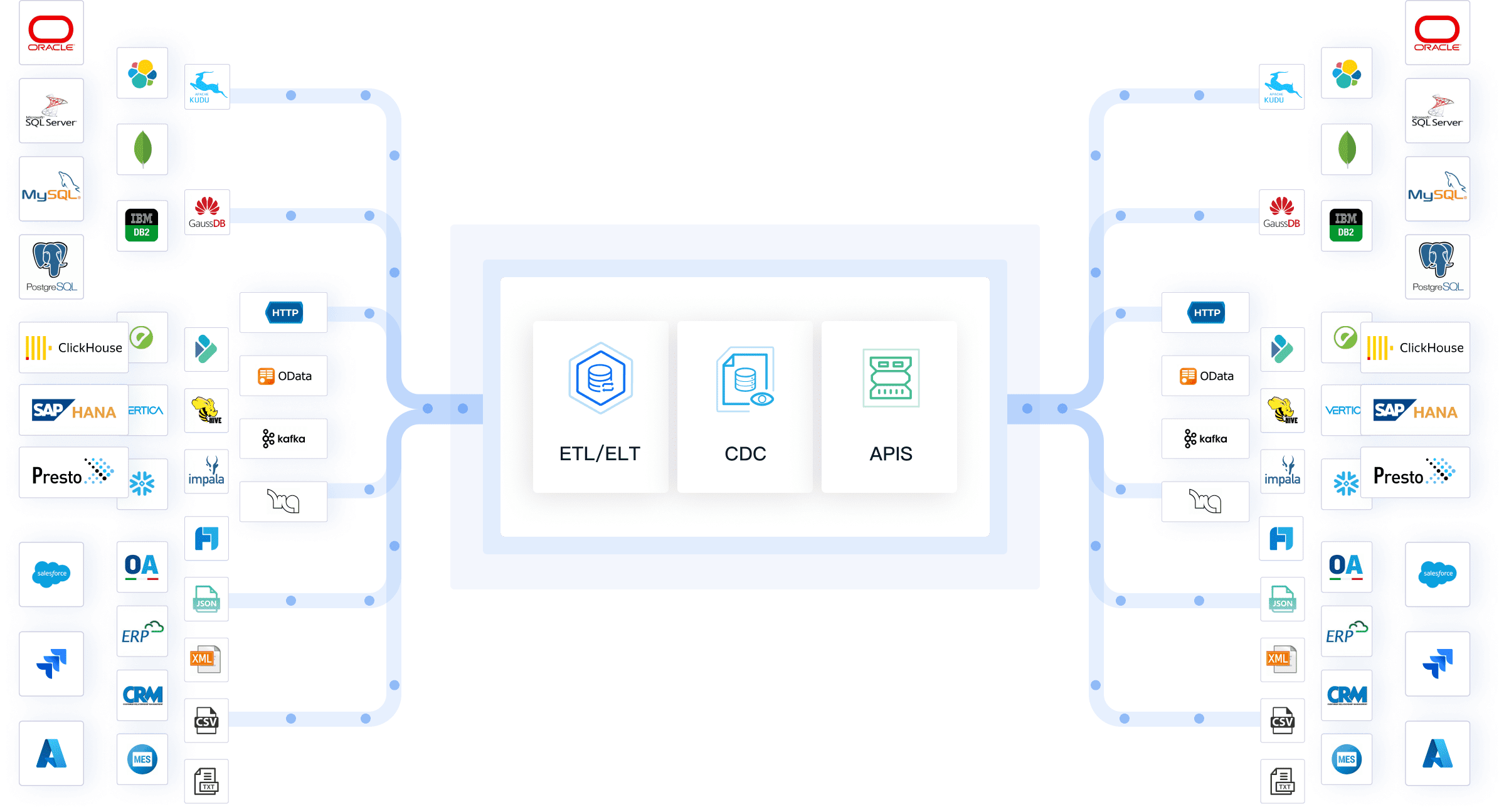Data warehousing services give you a structured way to collect, store, and manage data from multiple sources. You gain a single source of truth for business intelligence and better decision-making. When you integrate data effectively, you see measurable improvements in operational efficiency, revenue, and inventory management.
| Benefit | Impact on Business Performance Metrics |
|---|---|
| Enhanced Data Analytics | Improved decision-making and operational efficiency |
| Increased Revenue & ROI | Higher revenue generation through data-driven decisions |
| Increased Productivity & Efficiency | Streamlined operations and reduced time in data processing |
| Advanced Inventory Optimization | Better inventory management leading to cost reduction |
| Demand Forecasting | Aligns production with anticipated demand, improving efficiency |
Modern platforms such as FineDataLink solve complex data integration challenges and empower you to maximize the value of your data.
Data Warehousing Services Overview

What is a data warehouse
You need a clear understanding of what a data warehouse is before you can appreciate the value of data warehousing services. A data warehouse acts as a central repository for your organization's data. It collects, stores, and organizes data from multiple sources, making it accessible for analysis and reporting. You use a data warehouse to build a historical record, which helps you track trends and make informed decisions. The definitions below from leading industry sources highlight the core purpose and function of a data warehouse:
| Source | Definition |
|---|---|
| NetSuite | Data warehouses are computer systems that store, perform queries on, and analyze large amounts of historical data from multiple sources. They build a historical record that is invaluable to data scientists and business analysts. The data stored is of high quality, making it a definitive source of accurate data. |
| Domo | A data warehouse is designed for analytics, storing data from any and all applications and systems across an organization, functioning as a collection of databases. |
| Wikipedia | A data warehouse is a system used for reporting and data analysis, serving as a core component of business intelligence. It is a central repository of integrated data from one or more disparate sources, storing current and historical data for analytical reports. |
| IBM | A data warehouse centralizes and cleanses data from different sources to create a single source of truth, providing organizations with a comprehensive, reliable view of enterprise data. |
You rely on a data warehouse to unify data from different departments, applications, and systems. This centralization ensures that you have consistent, accurate, and reliable data for your business operations.
Core functions and value
Data warehousing services provide you with the tools and processes needed to build, manage, and optimize your data warehouse. These services help you overcome challenges such as fragmented data, inconsistent formats, and slow reporting. You benefit from several core functions that support your business operations:
- Data integration: You unify data from various sources into a single platform, ensuring consistency.
- Data cleaning: You remove duplicates and standardize formats to ensure accuracy and completeness.
- Data transformation: You convert data into a suitable format for analysis, enhancing its meaning.
- Data consolidation: You create a cohesive view of data, preventing fragmentation.
- Advanced querying: You perform complex analysis across extensive datasets for informed decision-making.
You also gain access to key architectural components that make your data warehouse effective:
| Component | Description |
|---|---|
| External Sources | Where data originates, including structured, semi-structured, and unstructured data types. |
| Staging Area | A temporary space for cleaning and validating raw data before it enters the warehouse. |
| Data Warehouse | Central storage for organized, cleansed data, supporting analysis and decision-making. |
| Data Marts | Focused sections of the data warehouse for specific teams, enabling quick access to relevant data. |
| Data Mining | Analyzing large datasets to find patterns and insights that support decisions and improve operations. |
You use data warehousing services to improve the accessibility and speed of your data reporting. Structured data allows you to analyze and report more efficiently. Enhanced access to data leads to more meaningful insights. Improved controls over data facilitate better decision-making. You also benefit from lower total cost of ownership, faster access to data, on-demand scalability, and greater flexibility.
Tip: When you choose data warehousing services, you enable your organization to produce more meaningful reports and gain better access and control over information. Reporting from a data warehouse is more effective than relying on transactional databases.
You see measurable improvements in your business performance when you implement data warehousing services. You reduce capital expenditures and maintenance costs, especially when you move to the cloud. You load and transform data more quickly, which enhances your reporting speed. You adjust resources as needed, ensuring optimal performance as your data grows. You integrate various data formats, adapting to changing business needs.
FineDataLink stands out as a modern data integration and warehousing platform. You benefit from a low-code, visual interface that simplifies complex data integration tasks. FineDataLink connects to over 100 data sources, supports real-time data synchronization, and offers advanced ETL/ELT development. You experience a user-friendly drag-and-drop environment, minimal latency, and scalable performance. FineDataLink helps you build an efficient and high-quality data layer for business intelligence, making it a cost-effective solution for organizations dealing with large volumes of data from multiple sources.

How Data Warehousing Services Work
Data integration and ETL
You need to understand the main processes that drive data warehousing services. The data warehousing process begins with data collection from multiple sources. You gather raw data from databases, applications, spreadsheets, and external platforms. This step is essential because it ensures you have all the information needed for analysis.
The next step is data integration. You combine data from different systems, which often use various formats, schemas, and languages. Data integration helps you create a unified view of your organization's information. You face challenges such as handling heterogeneous data formats, managing large volumes of data, and ensuring data quality. You also deal with duplicates, missing values, and inconsistent formatting. Data warehousing services address these issues by providing robust tools and strategies for data integration.
The ETL process is a core part of data warehousing. ETL stands for Extract, Transform, Load. You follow these steps:
- Extract: You retrieve raw data from various sources into a staging repository.
- Clean: You ensure the quality of the extracted data by removing duplicates and correcting errors.
- Transform: You structure and convert the data to match the target format required by your data warehouse.
- Load: You transfer the structured data into the data warehouse for analysis.
- Analyze: You process big data analysis within the warehouse to generate insights.
You use the data warehousing process to consolidate information, improve data quality, and prepare data for reporting and analytics. This process enables you to overcome data silos and fragmented workflows.
Real-time data synchronization
You need timely and accurate data for effective decision-making. Real-time data synchronization is a key feature of modern data warehousing services. This process ensures that changes in one system are immediately reflected in others, maintaining data integrity across your organization.
Technologies such as Change Data Capture (CDC) monitor database changes by tracking transaction logs. Event-driven architectures trigger updates across systems as events occur. Webhooks send notifications instantly when data changes, providing near-instantaneous updates compared to older polling methods.
Real-time data synchronization addresses challenges like fragmented workflows and manual errors. You automate data exchange between applications, which increases operational efficiency and eliminates silos. You also reduce data latency, ensuring that your data warehouse always contains the most current information.
You benefit from several advantages when you use real-time data synchronization in your data warehousing process:
- Improve decision-making with fresh, unified data.
- Enhance customer experiences through real-time personalization.
- Enable AI and analytics with clean, structured, streaming-ready data.
- Increase operational efficiency by eliminating manual tasks.
- Strengthen compliance and governance with consistent data flows.
You rely on real-time data synchronization to support business intelligence and analytics. This process provides you with the latest data, helping you respond quickly to market changes and customer needs.
FineDataLink in action
After understanding the general principles of data warehousing services, you can see how modern platforms like FineDataLink streamline these processes. FineDataLink offers a low-code, visual interface that simplifies complex data integration tasks. You use drag-and-drop tools to build data pipelines, reducing the need for manual coding.
FineDataLink supports real-time data synchronization, allowing you to process and integrate data from over 100 sources with minimal latency. You can synchronize business databases in real time, which reduces pressure on operational systems and ensures your data warehouse remains up to date.

The platform provides advanced ETL and ELT development features. You can preprocess data, schedule synchronization, and convert data formats efficiently. FineDataLink also enables you to create and launch API interfaces in minutes, making it easy to share data between different systems and SaaS applications.
| Feature | Description |
|---|---|
| Visualized Data Development | You visualize process flow and data flow for easier management. |
| Real-time Data Pipeline | You process and integrate data from various sources immediately. |
| Data Service Module | You transmit processed data securely across domains without writing code. |
| Flexible Data Processing | You use various transformation operators and batch synchronization. |
| Integration with External Processes | You connect with independent data processing through Shell scripts. |
FineDataLink helps you build an efficient and high-quality data layer for business intelligence. You gain a cost-effective solution for managing large volumes of data from multiple sources. The platform's low-code and API-driven capabilities make the data warehousing process faster, more reliable, and easier to manage.
Tip: When you choose a modern data warehousing service like FineDataLink, you simplify data integration, improve data quality, and enable real-time analytics for better business outcomes.
Types of Data Warehousing Services
Cloud, on-premises, and hybrid
You have several options when you choose a data warehouse for your organization. The three main deployment models are cloud data warehouse, on-premises data warehouse, and hybrid data warehouse. Each model offers unique advantages and challenges for your data warehousing services.
The cloud data warehouse is fully hosted by a third-party provider. You access your data through the internet, which allows you to scale quickly and pay only for what you use. This model is ideal for businesses that need flexibility and rapid deployment. You do not need to manage hardware or infrastructure, so you can focus on your data analytics.
The on-premises data warehouse is deployed within your company’s own data center. You have full control over your data and infrastructure. This model suits organizations with strict compliance requirements or legacy systems. You manage all aspects of maintenance and security, which can increase complexity and cost.
The hybrid data warehouse combines both cloud and on-premises environments. You store some data locally and some in the cloud. This model gives you flexibility and supports transitional architectures. You can optimize costs and performance by choosing where to store each type of data.
| Aspect | Cloud data warehouse | On-premises data warehouse | Hybrid data warehouse |
|---|---|---|---|
| Deployment | Hosted by cloud provider | Company data center | Mix of cloud and on-premises |
| Pricing model | Pay-as-you-go | High upfront investment | Medium upfront and ongoing |
| Cost scalability | Immediate scaling | Manual and costly scaling | Flexible with cloud |
| Infrastructure control | Limited | Full | Partial |
| Maintenance | Provider managed | In-house | Shared responsibility |
| Deployment time | Rapid | Long | Mixed |
| Security | Shared responsibility | Full responsibility | Shared |
| Data location | Global | Local | Mixed |
| Complexity | Low | High | Highest |
| Best for | Fast-growing, big data | Strict compliance, legacy | Specialized, transitional |
You should evaluate your business needs before selecting a data warehousing services model. Consider factors such as scalability, cost, control, and security.
Architecture basics
You need to understand the basic architecture of a data warehouse to make informed decisions about your data warehousing services. The architecture determines how your data flows from source systems to analytics tools.
Most organizations use a three-tier architecture for their data warehouse. The first tier is the central database, which stores integrated data for analysis. The second tier includes data integration tools such as ETL or ELT, which extract, transform, and load data from various sources. The third tier consists of access tools and interfaces, including business intelligence platforms and APIs, which allow you to query and visualize your data.
Key components of a data warehouse architecture include:
- Central Database (Storage): Stores all integrated data for analysis.
- Data Integration Tools (ETL/ELT): Extract, transform, and load data from source systems.
- Metadata Management: Organizes technical and business metadata for consistent reporting.
- Access Tools and Interfaces: Enable you to query and visualize data.
- Security & Governance: Control access and ensure compliance.
You may encounter single-tier or two-tier architectures, but these are less common due to performance and scalability limitations. The three-tier model supports large-scale data warehousing services and enables efficient analytics.
FineDataLink supports diverse data warehousing architectures. You can deploy it independently for maximum flexibility or integrate it with existing tools for streamlined operations. FineDataLink adapts to cloud, on-premises, and hybrid environments, helping you manage your enterprise data warehouse with ease. You benefit from real-time data integration, advanced ETL/ELT capabilities, and seamless connectivity across all deployment models.
Tip: When you choose a platform that supports multiple data warehousing services architectures, you gain the ability to scale, adapt, and optimize your data strategy as your business grows.

Data Warehousing Services Benefits

Analytics and decision-making
You gain powerful advantages when you use data warehousing services for business intelligence. A data warehouse acts as the foundation for analytics and reporting. You access data from multiple sources in one place, which speeds up your decision-making process. You analyze historical data to identify trends and predict future outcomes. You standardize data formats, which ensures consistency and accuracy across departments. You rely on advanced analytics tools to visualize data, build dashboards, and generate reports. These capabilities help you move away from assumptions and base decisions on reliable data insights.
Note: Data warehousing simplifies storage, management, and analysis. You act quickly and intelligently because you spend less time preparing data and more time generating data-driven insights.
| Benefit | Description |
|---|---|
| Faster Data Access | Enables organizations to generate reports and take faster action. |
| Foundation for Advanced Analysis | Provides a basis for advanced data analysis and reporting, yielding valuable insights. |
| Centralized Data Repository | Allows quick access to data from all channels for comprehensive analysis. |
| Improved Data Quality | Ensures high data quality and consistency by integrating and cleansing data from various sources. |
| Enhanced Decision-Making | Supports informed decision-making based on reliable and up-to-date data. |
| Cost Efficiency | Offers much lower operating costs compared to on-premise infrastructure. |
You integrate data from different sources into a unified view. You leverage machine learning for predictive analytics, which helps you forecast trends and optimize operations. You use data analytics to evaluate team performance and assess customer service, sales, and marketing effectiveness.
Use cases and success stories
You see measurable improvements in many industries when you implement data warehousing services. Companies use a data warehouse to optimize inventory, improve delivery efficiency, and enhance patient care. You benefit from customized dashboards that track key metrics and support data analytics for every department.
| Company | Industry | Key Implementations | Measurable Results |
|---|---|---|---|
| Amazon | Retail | Predicts customer preferences, Optimizes inventory | 35% improvement in inventory accuracy |
| UPS | Logistics | Real-time tracking, Route optimization, Predictive maintenance | 15% reduction in fuel consumption, 20% improvement in delivery efficiency |
| Mayo Clinic | Healthcare | Integrated patient data, Predictive health models | 25% faster patient diagnosis, Improved treatment protocol accuracy |
You use a data warehouse to store historical data, which allows for trend analysis and informed predictions. You speed up reporting and analytics, which leads to faster business decisions. You evaluate customer lifetime value and acquisition sources to improve marketing and sales strategies.
Tip: Focus on a specific area of your business when you start with data warehousing. This approach helps you gain momentum and credibility.

BOE customer story
You can see the impact of data warehousing services in the BOE Technology Group case. BOE faced challenges with fragmented data and inconsistent metrics. You learn from their experience that building a data warehouse helps consolidate data from multiple sources. BOE standardized metric definitions and created a unified analysis framework. You see how they automated data integration and improved processing efficiency. The company reduced inventory costs by 5% and increased operational efficiency by 50%. You notice that KPI dashboards and cross-factory benchmarking enabled real-time monitoring and data analytics. BOE’s transformation demonstrates how data warehousing supports business intelligence, enhances reporting, and drives digital growth.
Note: When you implement data warehousing services, you improve analytics, efficiency, and scalability. You empower your organization to make smarter decisions and achieve measurable results.

You see how a data warehouse transforms your business by centralizing data for quick access and reliable decision-making. You improve data accessibility, enhance analytics, and support long-term data storage. You drive efficiency by converting data into readable formats and boost productivity with centralized reporting. Modern platforms like FineDataLink streamline data integration, automate data synchronization, and deliver cost-effective solutions. You address challenges such as data quality, scalability, and security. You should evaluate your data warehouse needs and explore solutions that align with your business intelligence goals.
| Feature | Benefit |
|---|---|
| Real-time data synchronization | Timely access to data for decisions |
| Efficient data integration | Productivity through unified data sources |
| Low-code platform | Simplifies complex data warehouse tasks |
- Improved data accessibility
- Enhanced decision-making
- Increased business intelligence
- Long-term data storage
Tip: You should implement structured data warehouse models and optimize data processes to support future growth.

Continue Reading About Data Warehousing Services
Enterprise Data Integration: A Comprehensive Guide
What is enterprise data and why does it matter for organizations
Understanding Enterprise Data Centers in 2025
Enterprise Data Analytics Explained for Modern Businesses
FAQ

The Author
Howard
Engineer Data Management & Ahli Data Research Di FanRuan
Related Articles

Best Data Lake Vendors For Enterprise Needs
Compare top data lake vendors for enterprise needs. See which platforms offer the best scalability, integration, and security for your business.
Howard
Dec 07, 2025

Top Data Ingestion Platform Compared
Compare the top 7 data ingestion platforms, including real-time features, integration, scalability, and pricing to find the best fit for your business.
Howard
Dec 04, 2025

Best Data Lake Companies For Enterprise Needs
Compare top data lake companies for enterprise needs. See which platforms excel in scalability, integration, security, and analytics for businesses.
Howard
Dec 04, 2025



